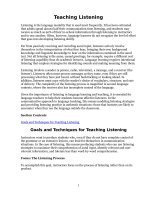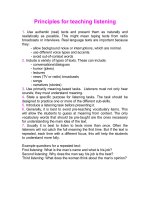Brown-Teaching-Listening
Bạn đang xem bản rút gọn của tài liệu. Xem và tải ngay bản đầy đủ của tài liệu tại đây (97.59 KB, 16 trang )
Teaching
Listening
Steven Brown
ca mbr idge
un ive rsity
pr ess
Cambridge, New York, Melbourne, Madrid, Cape Town, Singapore, São Paulo
Cambridge University Press
32 Avenue of the Americas, New York, NY 10013-2473, USA
www.cambridge.org
© Cambridge University Press 2006
This book is in copyright. Subject to statutory exception
and to the provisions of relevant collective licensing agreements,
no reproduction of any part may take place without
the written permission of Cambridge University Press.
First published 2006
Printed in the United States of America
Book layout services: Page Designs International
Table of Contents
Introduction 1
1
Activation of prior knowledge for improved listening
comprehension 2
2
Systematic presentation of listening for main ideas, listening for
details, and listening and making inferences 5
3
Stimulating integration of real-world cultural information for
students to know and share 7
4
Presentation of extensive listening tasks leading to personalized
speaking 9
References and Further Reading 11
Introduction
Two themes will wind through this discussion. The first is the necessity of sup-
porting students’ learning. Listening in another language is a hard job, but we
can make it easier by applying what we know about activating prior knowledge,
helping students organize their learning by thinking about their purposes for
listening, and if speaking is also a goal of the classroom, using well-structured
speaking tasks informed by research.
Another theme will be motivation. Because listening is so challenging,
teachers need to think carefully about making our activities successful and our
content interesting.
Both themes are united by a focus on the students. We need to capital-
ize on the knowledge and interests they already possess. Then we need to help
them apply that knowledge and those interests so they can become effective
listeners.
1
2 Teaching Listening
1
Activation of prior knowledge for
improved listening comprehension
One very important idea for teaching listening is that listening courses must
make use of students’ prior knowledge in order to improve listening compre-
hension. To make this idea clear, this section introduces several concepts from
the cognitive view of language learning, including schema, scripts, and top-
down/bottom-up processing. This section also considers the similarities and
differences between listening and reading, and then looks specifically at why the
activation of prior knowledge is perhaps even more important in listening than
in reading comprehension. Finally, there is a concrete example of activating
prior knowledge in listening materials.
We have known at least since the 1930s that people’s prior knowledge
has an effect on their cognition. Prior knowledge is organized in schemata
(the plural form of schema): abstract, generalized mental representations of our
experience that are available to help us understand new experiences. Another
way to look at this phenomenon is the idea of scripts. For example, everyone
who has been to a restaurant knows that there is a predictable sequence of ques-
tions involved in ordering a meal. In the United States these have to do with
whether you want soup or salad, the kind of dressing on the salad, choice of side
dishes, etc. Even if you do not hear a question, perhaps because the restaurant is
too noisy, you can guess from your place in the script what the server is proba-
bly asking. Unfortunately, this script does not transfer perfectly from country to
country because the routine is slightly different in each place. However, when
traveling in another country, and eating in a restaurant, you can make certain
assumptions about the kinds of questions that will be asked. If food has been
ordered but drinks have not, and the server asks another question, you might
fairly predict that the question is about the choice of drinks, based on your prior
knowledge of what happens in restaurants. Indeed, successful language learners
often can be separated from unsuccessful language learners by their ability to
contextualize their guesses and use their prior knowledge in this way.
The idea of prior knowledge is one part of the cognitive model of lan-
guage processing. That model says that when people listen or read, we process
the information we hear both top-down and bottom-up. Top-down means using
our prior knowledge and experiences; we know certain things about certain
topics and situations and use that information to understand. Bottom-up pro-
cessing means using the information we have about sounds, word meanings,
and discourse markers like first, then and after that to assemble our understand-
ing of what we read or hear one step at a time.









